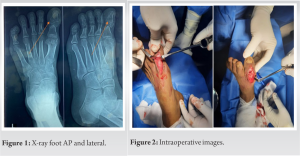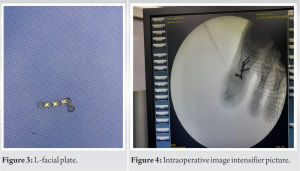Use of facial miniplates provide more screw placement resulting in increased stability and higher rate of union in non-union of proximal phalanx great toe.
Dr. J Harish Babu, Department of Orthopaedics, Saveetha Medical College and Hospital, Chennai - 602 105, Tamil Nadu, India. E-mail: harishjayakaran18@gmail.com
Introduction: Phalanx fractures of the lower limb have high rates of union when manage conservatively.
Case Report; A 26-year-old male with fracture of great toe proximal phalanx fracture which was initially managed conservatively with buddy strapping, who missed follow-up and presented late to outpatient department at 6 months with persistence of pain and difficulty in weight bearing. Here, we treated the patient with L-facial plate (2.0 system).
Conclusion: Fracture non-union of proximal phalanx can be managed surgically with L- facial plates and screw and bone grafting which will provide full weight bearing and walk normally without any pain and with adequate range of movements.
Keywords: Fracture, non-union, facial plates, bone grafting.
Fractures of the toe phalanges account for 2–3.6% of lower extremity injuries [1, 2]. There are no evidence-based recommendations for the acceptable alignment or indications for surgical intervention in closed foot phalangeal fractures in the literature, even though the injuries are very common. Usually, phalanx fractures result from something being dropped on the toes. These fractures frequently recover fully with mild neglect. Buddy strapping, which fixes a fractured phalanx to a nearby, unharmed toe, is a popular and efficient treatment. Another method is to wear inflexible and flat-bottomed shoes. While the union of fracture segments usually takes 3–8 weeks, tissue damage and stress can cause long-lasting pain. Desensitization therapy should be the focus of treatment. Non-union is an uncommon but enduring source of chronic pain that may necessitate orthopedic referral for surgical procedures to enhance the stiffness and biologic potential for healing of the fracture. Open fractures, open reduction methods, infection, and insufficient reduction or stabilization all increase the risk of non-union. In general, curettage, stabilization, and bone grafting are the standard treatments for a non-union. Compared to case studies of non-operative therapy, the few case reports of surgical management in the literature do reflect better outcomes in terms of range of motion, discomfort, and deformity.
History
A 26-year-old male had trauma to his left foot and sustained injury to his left great toe. He was unable to walk following injury and consulted in an outside hospital for primary care. He was diagnosed to have a fracture of proximal phalanx of left great toe. Conservative management was done in the form of buddy strapping. Patient came for review only after 6 months following injury and was diagnosed with great toe proximal phalanx non-union. At 6 months post-trauma, in our hospital, he presented with inability to walk normally and difficulty on full weight bearing due to pain in the left great toe. Patient was unable to carry on with his daily day to day activities.
Clinical finding
On examination of great toe, he had tenderness in proximal phalanx region with abnormal mobility at fracture site in all planes. Interphalangeal joint flexion was absent and metatarsophalangeal joint flexion of 10° and extension of 5° were present. There were no distal neurovascular deficits. The movements were significantly restricted due to pain.
Radiological finding
Plain radiograph of great toe showed displaced fracture fragments with sclerosed fractured ends and persistent visible fracture line with mild displacement in proximal phalanx (Fig. 1). Computed tomography (CT) of great toe revealed gap between fracture site and closed fracture ends thus confirming the diagnosis of fracture non-union of the proximal phalanx.
Plan
He was planned for open reduction and internal fixation with plate osteosynthesis and bone grafting.
Surgical procedure
Under ankle block, patient was placed in supine position on operating table. Parts painted and draped. Dorsal approach made with incision just medial to EHL tendon (Fig. 2). Fracture site reached after splitting EHL tendon. Fibrous tissue and callus were excised. Fracture site was curetted and debrided. Fracture site was packed with freshly harvested bone graft from iliac crest. After anatomical fracture reduction, internal fixation was done with 1.7 mm “L” shaped facial plate (Fig. 3) screws. Reduction checked with image intensifier (Fig. 4) Wound closure done after suturing EHL. Below knee splint applied with ankle in neutral position. Two-week post-surgery splint removed. Patient was started on partial weight bear walking after 4 weeks. Full weight bearing was started after 8 weeks (Fig. 5). At 3-month follow-up, patient was able to walk normally with improvement in range of movements. CT showed signs of fracture union with good rotational alignment (Fig. 6).
Bones of the great toe play an important role in the weight bearing mechanism of the foot, fracture of which may interfere with this mechanism and thereby affecting the gait. The metatarsophalangeal joint has intra-articular meniscus to enhance stability. Balance of the foot is maintained by the MTP joint during standing and bears up to 80% of the total load during the lift-off phase of the gait cycle [3]. A normal gait cycle involves complex foot motions where body weight acting on the heel is gradually transferred to the forefoot. Deformities and diseases of the foot impair normal walking. During the heel strike phase of the gait cycle, the great toe dorsiflexion at the metatarsophalangeal and interphalangeal joints helps in the ease in transfer of until the foot flat phase. Since load transfer takes place mostly on the medial side of the foot, disorders of the great toe are extremely important and need to be treated to achieve a normal gait. We applied the same principles as in any fracture non-union surgery, providing absolute stability by plating. Autograft is one of the most common and standard graft material used universally because of its osteoconductive, inductive, and osteogenic properties. This type of bone graft has advantage of not having risk of rejection or infection. Hand and foot fracture are treated with k wire and miniplates and the fixation principle is same for the both [4]. Miniplates provide absolute stability and neutralizes torsion, rotational, and shearing forces at the fracture site helping for early mobilization and rehabilitation [5, 6]. Miniplates and screw fixation are rigid enough fixation which will allow early mobilization preventing stiffness. Since the distal fragment in our patient was very small and to be able to secure more screws distally, we had used a 1.7 mm “L” shaped facial plate for internal fixation of fracture. Our study was comparable with that of Göksel et al. [7] where 4-year-old child presented with a great toe that had not yet united for which curettage of the fracture ends and two cross-pin fixations were carried out. Despite being usual for the treatment of non-union, the use of grafts was avoided since the fracture site had good blood flow, there was little bone loss, the patient was still young, and donor site morbidity was considered. In a study by Jupiter et al., [8] they have found that a rigid fixation provided by plating and lag screw techniques promotes union of bone and permits early motion of tendon and joint. In the 1st month, there was obvious unity. Whereas in Miiller and Allgower [9] and Segmiiller [10] have demonstrated successful union of “reactive” types of non-unions by applying fixation appliances without disturbing the non-union site or providing additional bone grafts. At the 1-year follow-up, the patient had no symptoms and the fracture had entirely healed. Whereas in our study, the fracture ends were closed and fracture gap was noticed, we treated the patient surgically by curettage, internal fixation with miniplates, and bone grafting. At 6-month post-surgery, patient had a painless great toe without any abnormal mobility. He was able to do interphalangeal joint flexion of 10 and extension of 5 and metatarsophalangeal joint flexion of 20 and extension of 10. There was complete union at the fracture site and patient was pain free. Although we achieved optimum results, this method has some limitations such as bone graft donor site morbidity which was not a major concern as very small amount of bone graft was harvested. Need for implant removal which is no necessary unless indicated, risk of infection, and implant tendon irritation. The outcome is measured using ankle foot scoring. The patient being a heavy laborer was able to carry on with his daily day to day activities. The patient had significant improvement in walking on any uneven surfaces. Patient was able to carry regular daily activities without any discomfort, postoperatively walking distance improved by a few blocks and ankle mobility was full and pain free. The pre-operative ankle foot scoring was done and found to be 31 and the post-operative scoring showed 96. Non-union in proximal phalanx fractures of great toe is rare. However, they still carry a significant morbidity. Our goal was to provide the patient a great toe with the ability to do full weight bearing and walk normally without any pain and with adequate range of movements. Following the patient’s inability to walk during the initial days post injury, patient also developed anterior talofibular ligament (ATFL) tendonitis. However, we were able to evaluate that the ATFL strain subsided significantly following fixation. Thereby causing painless transfer of weight and proper gait cycle.
This report describes a rare case of fracture non-union of proximal phalanx great toe. Fracture non-union of proximal phalanx great toe can be managed surgically with L-facial plates and screw and bone grafting which will provide full weight bearing and walk normally without any pain and with adequate range of movements.
Use of facial miniplates provides more screw placement resulting in increased stability and higher rate of union in non-union of proximal phalanx great toe.
References
- 1.Court-Brown CM, Caesar B. Epidemiology of adult fractures: A review. Injury 2006;37:691-7. [Google Scholar]
- 2.Hennessy MS, Saxby TS. Traumatic “mallet toe” of the hallux: A case report. Foot Ankle Int 2001;22:977-8. [Google Scholar]
- 3.King MA, Vesely BD, Teasdall RD. Great toe anatomy. Austin J Anat 2021;8:1100. [Google Scholar]
- 4.York PJ, Wydra FB, Hunt KJ. Injuries to the great toe. Curr Rev Musculoskelet Med 2017;10:104-12. [Google Scholar]
- 5.Yoon YC, Oh CW, Lee DW, Sim JA, Oh JK. Miniplate osteosynthesis in fracture surgeries: Case series with review of concepts. Injury 2020;51:878-86. [Google Scholar]
- 6.Agarwal AK, Pickford MA. Experience with a new ultralow-profile osteosynthesis system for fractures of the metacarpal and phalanges. Ann Plast Surg 2006;57:206-12. [Google Scholar]
- 7.Göksel F, Ermutlu C, Gölge UH, Kaymaz B. Non-union of the great toe in a 4-year-old child. BMJ Case Rep 2015;2015:bcr2015211709. [Google Scholar]
- 8.Jupiter JB, Koniuch MP, Smith RJ. The management of delayed union and nonunion of the metacarpals and phalanges. J Hand Surg Am 1985;10:457-66. [Google Scholar]
- 9.Miiller ME, Allgower M. Zur behandlung der pseudarthrose. HeIv Chir Acta 1958;25:253. [Google Scholar]
- 10.Segmiiller G. Surgical Stabilization of the Skeleton of the Hand. Baltimore: Williams & Wilkins; 1977. p. 92-9. [Google Scholar]












